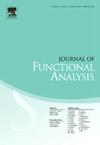Characterizations of the Crandall–Pazy class of C0-semigroups on Hilbert spaces and their application to decay estimates
IF 1.7
2区 数学
Q1 MATHEMATICS
引用次数: 0
Abstract
We investigate immediately differentiable -semigroups satisfying for some . Such -semigroups are referred to as the Crandall–Pazy class of -semigroups. In the Hilbert space setting, we present two characterizations of the Crandall–Pazy class. We then apply these characterizations to estimate decay rates for Crank–Nicolson schemes with smooth initial data when the associated abstract Cauchy problem is governed by an exponentially stable -semigroup in the Crandall–Pazy class. The first approach is based on a functional calculus called the -calculus. The second approach builds upon estimates derived from Lyapunov equations and improves the decay estimate obtained in the first approach, under the additional assumption that generates a bounded -semigroup.
求助全文
约1分钟内获得全文
求助全文
来源期刊
CiteScore
3.20
自引率
5.90%
发文量
271
审稿时长
7.5 months
期刊介绍:
The Journal of Functional Analysis presents original research papers in all scientific disciplines in which modern functional analysis plays a basic role. Articles by scientists in a variety of interdisciplinary areas are published.
Research Areas Include:
• Significant applications of functional analysis, including those to other areas of mathematics
• New developments in functional analysis
• Contributions to important problems in and challenges to functional analysis

 求助内容:
求助内容: 应助结果提醒方式:
应助结果提醒方式:


